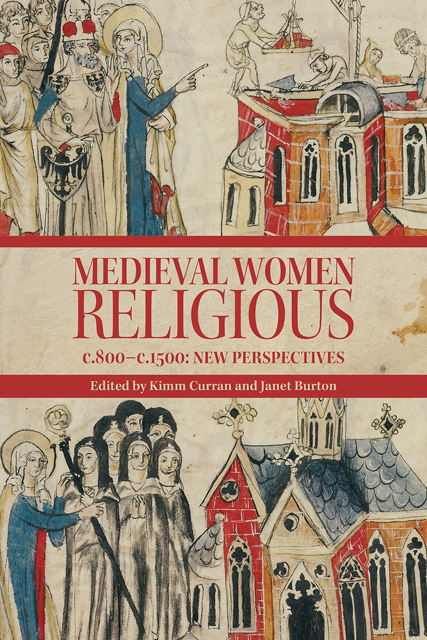Book contents
- Frontmatter
- Contents
- Illustrations
- Contributors
- Preface
- Abbreviations
- Introduction
- 1 Reform, Change, and Renewal: Women Religious in the Central Middle Ages, 800–1050
- 2 New Movements of the Twelfth Century: Diversity, Belonging, and Order(s)
- 3 Change and Renewal: Mendicants and Tertiaries in Later Medieval Europe
- 4 On the Fringes: Anchorites
- 5 ‘Quasi-religious’: Vowesses
- 6 Authority and Agency: Women as Heads of Religious Houses
- 7 Women Religious, Secular Households: The Outside World and Crossing Boundaries in the Later Middle Ages
- 8 Literacies, Learning, and Communal Reform: The Case of Alijt Bake
- 9 Family and Friends: Gift-giving, Books, and Book Inscriptions in Women’s Religious Communities
- 10 Communities of Medieval Religious Women and Their Landscapes
- 11 Materiality and Archaeology of Women Religious
- 12 Between Collective Memory and Individual Remembrance in Women’s Religious Communities
- Select Bibliography
- Index
- Miscellaneous Endmatter
Introduction
Published online by Cambridge University Press: 08 June 2023
- Frontmatter
- Contents
- Illustrations
- Contributors
- Preface
- Abbreviations
- Introduction
- 1 Reform, Change, and Renewal: Women Religious in the Central Middle Ages, 800–1050
- 2 New Movements of the Twelfth Century: Diversity, Belonging, and Order(s)
- 3 Change and Renewal: Mendicants and Tertiaries in Later Medieval Europe
- 4 On the Fringes: Anchorites
- 5 ‘Quasi-religious’: Vowesses
- 6 Authority and Agency: Women as Heads of Religious Houses
- 7 Women Religious, Secular Households: The Outside World and Crossing Boundaries in the Later Middle Ages
- 8 Literacies, Learning, and Communal Reform: The Case of Alijt Bake
- 9 Family and Friends: Gift-giving, Books, and Book Inscriptions in Women’s Religious Communities
- 10 Communities of Medieval Religious Women and Their Landscapes
- 11 Materiality and Archaeology of Women Religious
- 12 Between Collective Memory and Individual Remembrance in Women’s Religious Communities
- Select Bibliography
- Index
- Miscellaneous Endmatter
Summary
This book addresses varied aspects of the lives and communities of medie¬val women religious in western Europe. These lives and communities were complex and often transcended boundaries of what was expected of medieval women more generally: they might exhibit more in the way of agency, authority, and autonomy than previous scholarship has allowed – and certainly more in the way of ambiguity and fluidity in their ways of life. The complexity of defining women religious as one thing or another – enclosed religious, canoness, anchorite – or their role in medieval society, is found in the example of St Hedwig of Silesia (1174–†1243), duchess of Poland. Hedwig was educated in a women's religious community in her early years, a member of a well-connected family, considered pious, and participated in works of charity, especially for women. She was the founder of the women's community at Trebnitz, Poland – its construction and introduction of the community of women is pictured on the cover of this volume – and after the death of her husband, she moved into the community, where her daughter, Gertrude, was abbess, and resided there as a lay sister until her death.
Whilst her life may seem an exception to the norm, it serves as starting point in thinking about the perception of medieval women religious, how they are often defined or categorised, and compared with the lives and experiences of male reli¬gious. Indeed, St Hedwig is often viewed through the lens of her hagiography, the manuscript culture and production of the Vita, and late medieval art and devotional texts3 rather than in the context of late medieval monastic life, the varied religious experiences for women at the time, and her contribution to the regional identity of women religious more generally. This demonstrates that the lives of women religious and communities were diverse, not based solely on a life imagined or embodied in one text, and deserve further investigation.
Women Religious and Their Communities: A Survey of Historical Approaches
Despite the many recent studies of women religious,4 the dominant discourse still manages to make them footnotes, or separate categories, rather than placing them within wider monastic movements, and include them in the broad canvas of women's history of the Middle Ages. The many scattered references in general monastic histories or histories of monastic orders, for example, indicate how chal¬lenging it is to incorporate or place women religious within the wider context of orders and movements.
- Type
- Chapter
- Information
- Medieval Women Religious, c.800-c.1500New Perspectives, pp. 1 - 21Publisher: Boydell & BrewerPrint publication year: 2023



